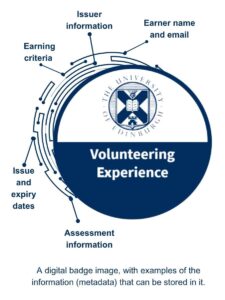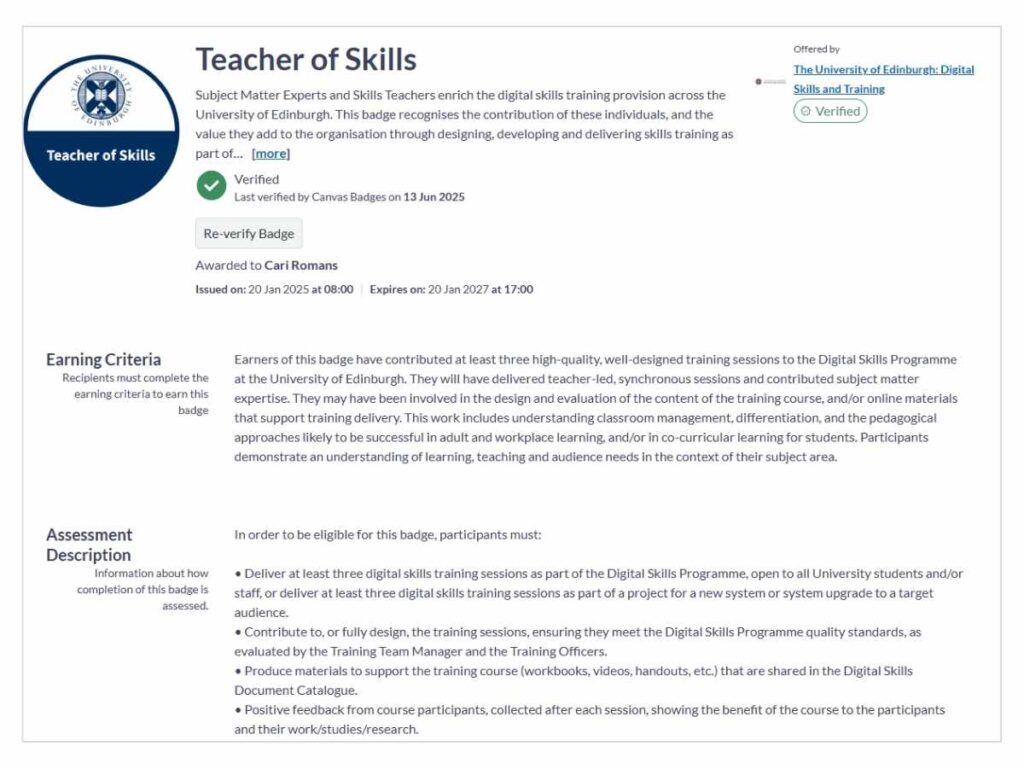What do digital badges mean for the people looking at them?
Summary
A digital badge offers a way verify and find out more details about a person's skills and achievements, particularly for a prospective employer. This is best done by verifying the badge and considering the details in context — the badge issuer, the likely quality of the badge, the badge's earning criteria, and how relevant the badge is to what you're looking for.
Digital badges are great for people who earn them, giving them (another) way to evidence something they have achieved. They’re great for the organisations who issue digital badges because digital badges give them a flexible, scalable way to recognise achievements or learning and encourage professional development.
But what about the people who are looking at these sleek little badge images with interesting names in CVs, portfolios and LinkedIn profiles? How can they use digital badges? And how should they make sense of them?
Digital badges can actually be very useful for the people looking at them— perhaps as a prospective employer or someone assessing applications for something. Digital badges can help you dig deeper into what skills a person has really shown and verify evidence of those skills or achievements. Digital badges might also give you an idea of a person’s commitment to learning, growth and professional development.
Digital badges – more than just a pretty picture
A digital badge is simply an image that offers a way for you to verify and get more detail about someone’s skills, achievements or training.
Yes, it’s a simple little image. But it’s an image with layers and meaning.
It’s a bit like a traditional paper certificate for a learning activity, except with all the details of who earned the certificate, when, and exactly what they did to earn it printed on the back of the certificate, with a big green verified stamp on it.
For a digital badge, you can see the image of the badge, and all that information about who did what, when, and where to earn the badge is ‘baked inside’ as metadata (information).

So, what do I do with the digital badge someone shared with me?
As a prospective employer or someone assessing applications, you would want to do a few things with the digital badge in the CV or LinkedIn page.
- Verify the badge is authentic and current. This is usually done by clicking on a link or image, which takes you to a site where you can see the details.
- Consider who issued the badge (e.g., a school, organisation, company, etc.). Ideally, the badge is from a recognised and reputable issuer.
- Look at the details of the badge. Are the activities and assessment consistent with the skills or achievements the badge claims to represent? How comparable is it with other badges or certificates in terms of effort, skill, knowledge, etc.?
- Decide how relevant the digital badge is to what you’re looking for. This is best done by looking at exactly what was done to earn the badge. For example, presenting at a conference does not show the same skills as organising a conference. Also, take a look at the level of skill or knowledge demonstrated by the activities the badge represents.
Digital badges can be issued for all sorts of things — practical experience, workshops, projects, levels of skill, study or work abroad, awards and more. They can be especially good for recognising and verifying activities that don’t necessarily show up in more traditional records like education transcripts and human resources records.
Digital badges can be issued by all sorts of places — educational institutions, employers, organisations, professional bodies, etc. That does mean you, as the badge viewer, do want to look into the details of the badge.
Look to see if the badge issuer (who awarded the badge) is recognised, with a good reputation and who is likely to have quality control around their badges. Some badges represent a great deal of hard work, a major effort, or evidence of a valuable skill. However, there are some badges out there that are basically certificates of participation (also known as thanks for turning up).
The nice thing is you, as the prospective employer, can easily use the badge’s metadata to check exactly what was done to earn the badge, if it was in fact issued to this person, and whether it’s still ‘in-date’.
You do this by verifying the badge.
Is it real? Verifying a digital badge
If the person has shared a link or clickable image with you, the chances are that clicking on them will take you to the badge issuer’s site or a badge verification site. From a LinkedIn profile, you can often click the button to ‘show credential’. The details about the badge should then display for you to see.
In the example below from my own digital badges, you can see:
- An image of the badge, with a description and who awarded the badge (issuer).
- A green tick mark and text showing the badge has been verified.
- If the badge was not verified or is no longer valid, the text and colours will say so.
- When it was last verified, and a button to re-verify the badge.
- The name of the person the badge was awarded to.
- When the badge was issued and, if applicable, when it expires.
- Earning criteria: What the person did to earn the badge.
- Assessment description: How the badge issuer decided the person met the earning criteria and should get the badge.

Details, details – but important details
The distinction between earning criteria and assessment can be subtle, but it’s crucial for you to get an idea of how meaningful and relevant the skills or experience evidenced by the badge would be in your context.
For example, in the case of my badge above, the earning criteria specify contributing to and delivering at least three high-quality, well-designed digital skills sessions, including developing training content and showing an understanding of learning and teaching.
The assessment description gets more specific. It says which sessions can be counted, who evaluates the quality of the sessions, what materials should be produced and where they should be shared, and that the sessions must have had positive feedback.
As another example, the University of Edinburgh badge Developing Your Data Skills Level 1 requires 19.5 hours of workshops and online learning and the completion of a data project. These are the earning criteria. The assessment is done by turning in certificates of completion for the learning experiences, and the programme manager assess the data project on specific criteria.
If you’re curious and have a moment, you can explore a few of the nearly 100 badges currently on offer in University of Edinburgh digital badges catalogue. All of these badges are designed to represent extra-curricular or professional development skills or achievements.
They are issued by different programmes and sections within the University, and the skills and achievements they represent are diverse. Because of that, the earning criteria and assessments are suited to the badge and also diverse. But all the badges have all been through our own quality assurance process before going onto the platform.
The earning criteria and assessment descriptions are clearly spelled out in a way that should help you, as the badge viewer, understand exactly what was done so you can determine what that badge might mean in your context and for your application process.
University of Edinburgh Digital Badges Catalogue
To find out more about the University’s digital badging service, visit the BadgEd website.
For more general information on digital badges, you can also take a look around the Digital Badging Commission’s website.
Digital Badging Commission (UK)



